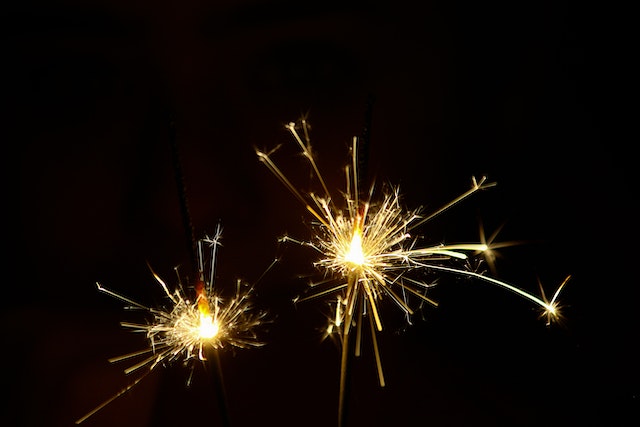
How do sparklers work? They burn a combination of metal particles that combust in different colors.
Sparklers are coated in a mixture of metal powders and a type of sugar called dextrin. They also contain nitrates and sulfur or charcoal. Each of these ingredients has a different purpose. You must have held a sparkler at some point in your life. You light the tip and they burst into beautiful multicolored sparks for as long as it takes the sparkler to burn down (20 seconds if you bought a cheap one, over a minute if you bought an expensive one).
A sparkler has four necessary components. These are the stick, a metallic fuel, an oxidizer, and a combustible binder.
The first part of the sparkler is the metal stick you hold. You can get sparklers with wooden sticks, but most of them are made of steel wire these days. When the sparkler burns, the wood will also burn producing smoke, which is why most are made with metal. Steel dissipates heat much faster than wood can, so it doesn’t get hot. An advantage if you are going to hold it.
The next thing that you need is the metallic fuel. This is what produces the colored sparks. Different metals can produce different colors. For example, magnesium produces a white spark, iron produces an orange spark, and ferrotitanium can produce a golden spark. The metals burn with different colors because they release different amounts of energy. When the metal is heated, some of the electrons get excited and jump to higher energy levels. They cannot stay at that level for long because it is unstable, so they soon fall back to their original level. When they do, they release energy and that energy is released as a wavelength. The electrons in different metals needs different amounts of energy to jump to another energy plane, so they give off different wavelengths of energy, causing the different colors we see. The metals are added to the sparkler as a powder. They burn explosively, being ejected from the sparkler as the burn, causing the sparks.
Then the sparkler has to have an oxidizer. The metal fuel on the sparkler needs to reach an extremely high temperature in order to burn. To get that hot, the fuel needs more oxygen than is available in the air around it. The oxidizer is a chemical such as potassium nitrate. When potassium nitrate burns, it breaks down into potassium chloride and oxygen. The oxygen combines with the metal, helping it reach a higher temperature. The heat from the metal keeps the potassium nitrate breaking down and releasing oxygen.
The last thing you must have is something to hold it all to the stick. The metal and the potassium nitrate are mixed with a binder such as dextrin. This is a carbohydrate, so basically a sugar. The dextrin is moistened and sets when it dries, holding everything to the stick. When the sparkler is lit, the dextrin burns as well, giving even more heat energy to the metal and the oxidizer.
Without these things, the sparkler will not work. It is possible to add a few more optional things. You can add sulfur or charcoal as an extra fuel. These produce more heat when combined with the oxidizer. Sometimes other things, like cornmeal, can be added to make the sparkler burn for longer. Other colors can be added and mixing metals is also possible.
Sparklers were invented in Germany in 1850. They were called wunderkerzen and they were basically a wire dipped in gunpowder. Wunder means “wonderful” and kerzen means “candles”.
Sparklers are marketed at children because they appear safe but they burn at an incredibly high temperature and are responsible for over 60% of firework-related injuries every year. This is surprisingly not because of the sparks they produce. Iron has to reach 1,315˚C to burn. When the iron powder burns, the sparks are flung out and they are hot, but they have almost no mass so they don’t have much thermal energy. Also, because of this small mass, they lose their energy extremely quickly. So, why are sparklers responsible for so many injuries? It’s because of the temperature of the burning sparkler itself. If you touch the burning part, it will be incredibly hot. Children don’t know this, and they might touch other people, or grab the bright part themselves. Always supervise your children. And this is what I learned today.
Sources
https://en.wikipedia.org/wiki/Sparkler
https://www.mcgill.ca/oss/article/technology-you-asked-general-science/how-do-sparklers-work
https://www.wired.com/2014/07/the-awesome-physics-in-a-simple-sparkler/
https://www.thoughtco.com/how-do-sparklers-work-607351
https://physics.stackexchange.com/questions/252411/why-do-some-elements-burn-different-colors
